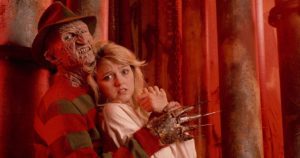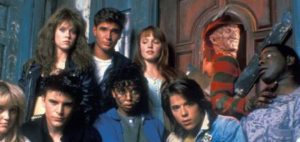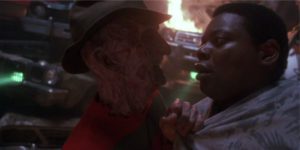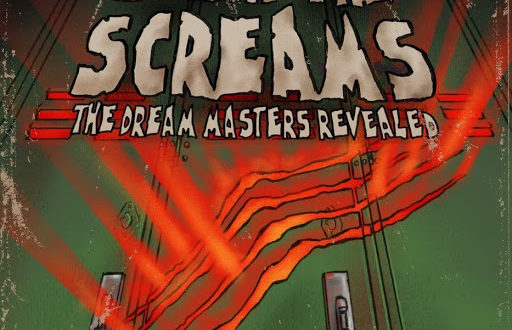Back then in the late ’80s and early ’90s, we didn’t have the luxury of YouTube or DVD extras to satisfy our cravings for the inside stories on what went on during the making of our favorite spooky films. After much begging and negotiation, my parents finally relented and bought me a subscription to Fangoria magazine, which I would pounce on the moment it showed up in our mailbox, savagely scanning each article for every drop of extra details they had on my ever growing list of watched horror catalogue.
When I finally began to find the rare Making Of videos, I would watch them over and over until the VHS tape became virtually unwatchable. As time went on, and the subgenre grew in popularity, I was elated to get access to more and more behind the scenes looks at how the sausage was made.
Nowadays, you can log onto YouTube and find a virtual plethora of “how it was made,” behind the scenes docs on almost any classic horror movie made during that great era. You would get the classic formula of interviews starring the writers, the stars, a couple of producers, and of course, the director, which was great… the first 20 or 30 times. But it eventually began to feel like something was missing, something that I couldn’t quite put my finger on. That all changed the moment I read Behind the Screams by Mick Strawn and Blake Best.

The Writer
Mick Strawn is a production designer with a background in special effects. He has worked his magic on such films as Blade, Boogie Nights, Candyman, Buffy the Vampire Slayer, Leatherface, and of course A Nightmare on Elm Street 3 and 4. A production designer’s task is to take charge of all aspects of a film that has to do with how the tone comes across visually and emotionally. If there is a house that haunts your dreams, it first haunted a production designer’s dreams until they got it built so perfectly that they were sure it would be burned into your nightmares.

The Book
Behind the Screams is Mick Strawn’s baby, a book that was simmering in the dark recesses of his twistedly talented mind. Each time Mick would go to a convention, he would see panels made up of the same people retelling the same stories from their point of view. With each panel he sat through, the ground in his mind would begin to rumble and crack, and slowly the fires of determination would push him, along with his peers in the industry, to put together a book from the perspective of those people who are never seen. For the longest time, we were getting the stories from the viewpoint of people who lived in “the world.” Now, for the first time ever, we get the story from the ones directly involved with imagining, managing, and actually building that world.
Behind the Screams is a compilation of interviews with these talented artists telling almost unbelievable stories behind the creation of A Nightmare on Elm Street 4: The Dream Master. This film was made in a perfect storm of how a movie is never made. There was a writer strike going on, so there was no story to speak of. Nightmare 4 was made with the biggest budget a Freddy movie had ever seen, and constructed mainly by the technical people who were charged to dream up the plots while building their lots. The actors and art department worked together to create a film born of talent and dedication, a one time phenomena that spawned some of the most unique stories and points of view I’ve ever seen put to print.
The book highlights the primal nature of the sets and how they dictated the flow of the film. We get to hear cast members focus on how their surroundings grounded their experiences and interactions, and how it was made real by the world that was built around them. NOES 4 was made at the pinnacle of practical effects, and fully constructed sets with gags that have set a standard in visual wizardry, still being borrowed from to this day.

Mick and Blake suck the reader into their world just like the stunning effects that Mick designed from the theater scene where Alice Johnson gets sucked into the theater screen. Every single effect that racked my brain as a kid is explained in excruciating detail, and what I mean by that is you feel the pain of the crew when gags went so wrong, where they had to scrap ideas and start over from scratch with virtually no time before shooting was to take place. There were four units running, and Mick was ripping across southern California on a daily basis in a time where pagers and phone booths were the only medium of communication. Behind the Screams makes you feel the exhaustion of the actors being rigged up for a scene and left hanging while the crew broke for lunch, the never ending battles between the balance of getting the look and feel of “the world,” and Mick just trying to get it on the screen versus the people controlling the budget just pops off the page from chapter to chapter, making the book impossible to put down.
The actors and art department worked together to create a film born of talent and dedication, a one time phenomena that spawned some of the most unique stories and points of view I’ve ever seen put to print.
I finished reading Behind the Screams on a flight from Montreal to San Francisco, and eventually realized I was being stared at because of multiple actual laugh out loud moments. One which comes to mind is that, no matter who he was talking to, many of the set or effects people would cut him off and exclaim, “The fire pissing dog!” It busted me up every single time.
As a kid, I remember the huge media coverage and hype behind Nightmare 4, and particularly one night while watching Entertainment Tonight. The show gave the viewer a preview of all the major gags that are discussed in the book. To this day, I still remember the teaser scene of the massive junkyard maze, my jaw dropping to the floor, leaving me wide-eyed and trying to make sense of what I just saw. I never thought that I would ever be able to revisit that emotion and awe I felt as a child back then, but through Mick’s interviews and detailed stories reliving his excitement of conceiving it, to figuring out how to actually build it, to the awe of the actors who had the opportunity to act and pull inspiration from it, brought me right back to a moment I thought was lost forever.

Imagine how I felt while my plane was just about to push from the San Fran airport, and I was messaging with Mick back and forth about the stuff covered in the text, and he’s feeding me extras that didn’t make the book… keep an eye out for our interview that will touch on that and how we met.
As I mentioned before, we are treated to stories in Mick’s conversations with the behind the scenes greats of the industry, other technical wizards who worked on other films who were just blown away to find out to what extent Mick would go to in order to realize an impossible effect sequence. No stone is left unturned in this tale of the man behind the curtain. From a chapter dedicated to the music and how it was inspired by the times, to the actor’s no holds barred opinions of the director, Behind the Screams has something for everyone. The book is peppered with behind the scenes photography and inserts of actual script pages that put the reader into the movie, picking their favorite characters and reading the lines.
Final Thoughts
It pains me to stop this review here because I could go on and on about this book. As this is a review, I have to balance this out with some very small and inconsequential gripes. First of all, the book’s photos taken from the sets left me feeling that I really wished had descriptions underneath of exactly what was going on when they were taken. The second gripe is that I felt the editor missed some basic errors that made to print. Like I said, minor gripes that in no way effect the readability. In all honesty I will be reading this book again. I also wanted to note that Mick’s late sister CJ who was a masterful artist in her own rite also worked on the film. After watching the film again her work with set dressings such as the flowing cloth in the nightmare scenes now stand out as subconscious triggers that “sold it” to the audience.
If you loved A Nightmare on Elm Street 4, the series in general, or are a true Cinefile waiting for a behind the scenes take on a film from an angle that has never been explored I’m telling you, this is a book that must be a part of your collection.

Pick up your copy by clickinbg the link below!
 PopHorror Let's Get Scared
PopHorror Let's Get Scared




